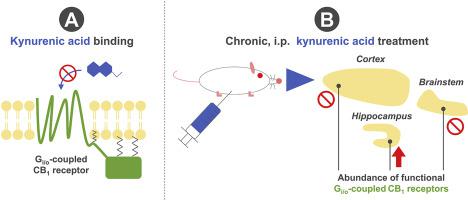Neurochemistry international ( IF 4.2 ) Pub Date : 2020-05-20 , DOI: 10.1016/j.neuint.2020.104752 Ferenc Zádor 1 , Gábor Nagy-Grócz 2 , Szabolcs Dvorácskó 3 , Zsuzsanna Bohár 4 , Edina Katalin Cseh 5 , Dénes Zádori 5 , Árpád Párdutz 5 , Edina Szűcs 6 , Csaba Tömböly 1 , Anna Borsodi 1 , Sándor Benyhe 1 , László Vécsei 4

|
Kynurenic acid (KYNA) is one of the most significant metabolite of the kynurenine pathway both in terms of functional and potential therapeutic value. It is an N-methyl-D-aspartate (NMDA) receptor antagonist, but it can also activate the G-protein coupled receptor 35 (GPR35), which shares several structural and functional properties with cannabinoid receptors. Previously our group demonstrated that systemic chronic KYNA treatment altered opioid receptor G-protein activity. Opioid receptors also overlap in many features with cannabinoid receptors. Thus, our aim was to examine the direct in vitro and systemic, chronic in vivo effect of KYNA on type 1 cannabinoid receptor (CB1R) binding and G-protein activity.
Based on competition and [35S]GTPγS G-protein binding assays in rat brain, KYNA alone did not show significant binding towards the CB1R, nor did it alter CB1R ligand binding and agonist activity in vitro. When rats were chronically treated with KYNA (single daily, i.p., 128 mg/kg for 9 days), the KYNA plasma and cerebrospinal fluid levels significantly increased compared to vehicle treated group. Furthermore, in G-protein binding assays, in the whole brain the amount of G-proteins in basal and in maximum activity coupled to the CB1R also increased due to the treatment. At the same time, the overall stimulatory properties of the receptor remained unaltered in vehicle and KYNA treated samples. Similar observations were made in rat hippocampus, but not in the cortex and brainstem. In saturation binding assays the density of CB1Rs in rat whole brain and hippocampus were also significantly enhanced after the same treatment, without significantly affecting ligand binding affinity.
Thus, KYNA indirectly and brain region specifically increases the abundance of functional CB1Rs, without modifying the overall binding and activity of the receptor. Supposedly, this can be a compensatory mechanism on the part of the endocannabinoid system induced by the long-term KYNA exposure.
中文翻译:

犬尿酸脑区的长期全身给药特异性地提高了大鼠中功能性 CB1 受体的丰度。
犬尿氨酸 (KYNA) 是犬尿氨酸途径中最重要的代谢物之一,无论是在功能还是潜在治疗价值方面。它是一种N-甲基-D-天冬氨酸 (NMDA) 受体拮抗剂,但它也可以激活 G 蛋白偶联受体 35 (GPR35),该受体与大麻素受体具有多种结构和功能特性。此前,我们的团队证明全身性慢性 KYNA 治疗改变了阿片受体 G 蛋白活性。阿片受体在许多特征上也与大麻素受体重叠。因此,我们的目的是检查KYNA 对 1 型大麻素受体 (CB 1 R) 结合和 G 蛋白活性的直接体外和全身慢性体内影响。
根据大鼠脑中的竞争和 [ 35 S] GTPγS G 蛋白结合测定,单独使用 KYNA 没有显示出对 CB 1 R 的显着结合,也没有改变体外CB 1 R 配体结合和激动剂活性。当大鼠用 KYNA 长期治疗(每天一次,ip,128 mg/kg,持续 9 天)时,与载体治疗组相比,KYNA 血浆和脑脊液水平显着增加。此外,在 G 蛋白结合测定中,在整个大脑中,与 CB 1偶联的基础和最大活性中 G 蛋白的数量R 也因治疗而增加。同时,受体的整体刺激特性在载体和 KYNA 处理的样品中保持不变。在大鼠海马中进行了类似的观察,但在皮层和脑干中没有。在饱和结合测定中,大鼠全脑和海马中CB 1 Rs的密度在相同处理后也显着增强,而没有显着影响配体结合亲和力。
因此,KYNA 间接地和大脑区域特异性地增加了功能性 CB 1 Rs的丰度,而不改变受体的整体结合和活性。据推测,这可能是长期暴露于 KYNA 引起的内源性大麻素系统的一种补偿机制。



























 京公网安备 11010802027423号
京公网安备 11010802027423号